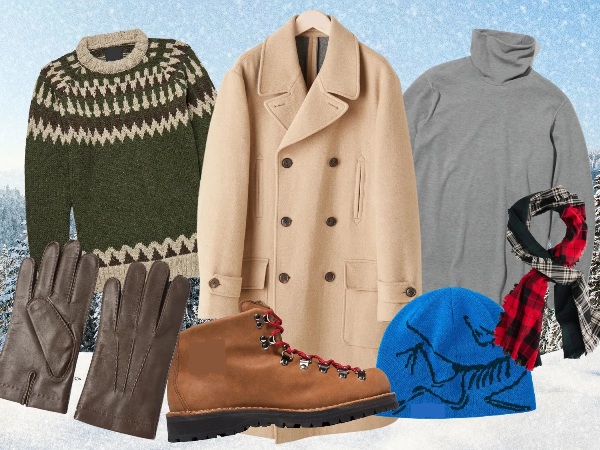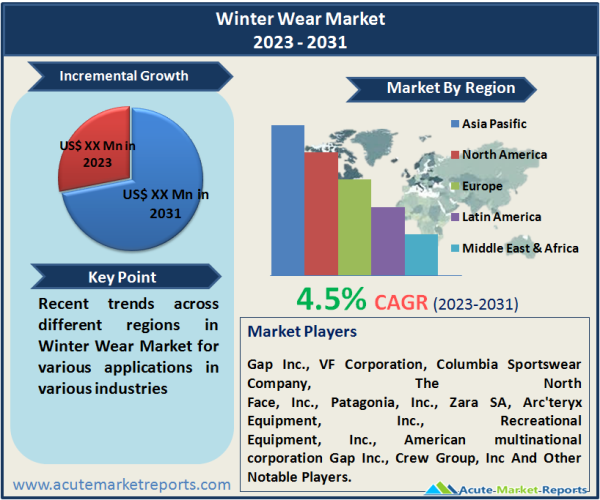
The winter wear market is a crucial segment of the fashion industry, with consumers seeking warmth, comfort, and style during the cold months. The winter wear market is expected to grow at a CAGR of 4.5% during the forecast period of 2025 to 2033, driven by seasonal climate variations, fashion trends, and the convenience of e-commerce. While economic fluctuations and income levels may pose a restraint, the market offers ample opportunities for manufacturers to cater to diverse product categories, consumer groups, and geographic regions. The competitive landscape is marked by established players and emerging companies, all striving for innovation and market dominance. The market's future from 2025 to 2033 promises exciting developments and opportunities for both consumers and manufacturers.

Seasonal Climate Variations
One of the primary drivers of the winter wear market is the seasonal climate variations. As winter approaches each year, consumers are prompted to invest in winter wear such as Sweaters and Cardigans, Jackets, Coats, and Blazers, Scarves, Shawls, Wraps, Stoles, Mufflers, Sweatshirts, Hoodies, Pullovers, Thermals, Gloves, and Accessories. The winter season consistently drives demand for these products, with consumers looking for both functionality and fashion. This driver is expected to remain strong as climate fluctuations persist.
Fashion Trends and Style Preferences
Fashion trends and style preferences play a crucial role in driving the winter wear market. Consumers, including Men, Women, and Kids, are increasingly conscious of their winter wardrobe, seeking not only warmth but also stylish apparel. Winter wear manufacturers continually innovate to align their products with changing fashion trends, offering a wide range of designs, colors, and materials. This driver is expected to maintain its significance as consumers prioritize fashion in their winter attire.
E-commerce and Online Shopping
The growth of e-commerce and online shopping has significantly boosted the winter wear market. With the convenience of shopping from home, consumers can explore a vast selection of winter wear products, compare prices, and read reviews. Online platforms have become a go-to destination for purchasing Sweaters and Cardigans, Jackets, Coats, and other winter wear items. The e-commerce trend is expected to continue, driving market growth in the forecast period.
Economic Fluctuations and Income Levels
Economic fluctuations and income levels present a significant restraint for the winter wear market. The affordability of winter wear products is closely linked to consumers' disposable income. In times of economic uncertainty, consumers may cut back on discretionary spending, impacting the sales of winter wear. This restraint is evidenced by the market's sensitivity to economic conditions, and it may become more pronounced during periods of economic downturn.
Market Segmentation by Product: Jackets, Coats, and Blazers Dominate the Market
The winter wear market encompasses a wide range of product categories, including Sweaters and Cardigans, Jackets, Coats, and Blazers, Scarves, Shawls, Wraps, Stoles, Mufflers, Sweatshirts, Hoodies, Pullovers, Thermals, Gloves, and Accessories. In 2024, Jackets, Coats, and Blazers generated the highest revenue, while Accessories exhibited the highest CAGR during the forecast period of 2025 to 2033. This dynamic indicates a notable demand for both functional outerwear and winter accessories.
Market Segmentation by Consumer Group: Women's Segment Dominate the Market
The market can also be segmented based on consumer groups, including Men, Women, and Kids. In 2024, the Women's segment recorded the highest revenue, while the Kids' segment is projected to have the highest CAGR from 2025 to 2033. This suggests a growing market opportunity for winter wear manufacturers to cater to the children's segment, taking into account both their functional and fashion needs.
Asia-Pacific to Promise Significant Opportunity During the Forecast Period
Geographically, the winter wear market shows variations in trends. Different regions experience distinct patterns, with some areas having higher revenue and others achieving a more significant CAGR. The region with the highest CAGR during the forecast period is Asia-Pacific, driven by its large population and increasing urbanization. North America, with its diverse climate, has been the region with the highest revenue in 2024, indicating a well-established market for winter wear.
Competitive Trends
The winter wear market's competitive landscape is marked by intense rivalry among key players, including leading companies such as Gap Inc., VF Corporation, Columbia Sportswear Company, The North Face, Inc., Patagonia, Inc., Zara SA, Arc'teryx Equipment, Inc., Recreational Equipment, Inc., American multinational corporation, Crew Group, Inc and others. These companies are at the forefront of innovation, consistently investing in research and development to enhance their winter wear technology. They have established themselves as leaders in the market through a combination of high-quality products, fashion-forward designs, and strategic partnerships. Their revenues in 2024 reflect their market leadership, and they are expected to continue their growth during the forecast period from 2025 to 2033. In addition to these major players, there is a growing number of emerging companies entering the winter wear market, especially in regions with high growth potential. These newcomers are focused on developing cost-effective winter wear solutions and expanding accessibility. Strategic partnerships and collaborations are key trends in the market, with established players working with e-commerce platforms to implement winter wear technology effectively, reaching a broader audience and improving the overall shopping experience.
Historical & Forecast Period
This study report represents analysis of each segment from 2023 to 2033 considering 2024 as the base year. Compounded Annual Growth Rate (CAGR) for each of the respective segments estimated for the forecast period of 2025 to 2033.
The current report comprises of quantitative market estimations for each micro market for every geographical region and qualitative market analysis such as micro and macro environment analysis, market trends, competitive intelligence, segment analysis, porters five force model, top winning strategies, top investment markets, emerging trends and technological analysis, case studies, strategic conclusions and recommendations and other key market insights.
Research Methodology
The complete research study was conducted in three phases, namely: secondary research, primary research, and expert panel review. key data point that enables the estimation of Winter Wear market are as follows:
Market forecast was performed through proprietary software that analyzes various qualitative and quantitative factors. Growth rate and CAGR were estimated through intensive secondary and primary research. Data triangulation across various data points provides accuracy across various analyzed market segments in the report. Application of both top down and bottom-up approach for validation of market estimation assures logical, methodical and mathematical consistency of the quantitative data.
| ATTRIBUTE | DETAILS |
|---|---|
| Research Period | 2023-2033 |
| Base Year | 2024 |
| Forecast Period | 2025-2033 |
| Historical Year | 2023 |
| Unit | USD Million |
| Segmentation | |
Product
| |
Consumer Group
| |
Fabric
| |
Distribution Channel
| |
|
Region Segment (2023-2033; US$ Million)
|
Key questions answered in this report